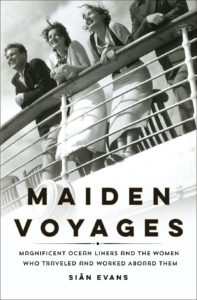In Maiden Voyages: Magnificent Ocean Liners and the Women Who Traveled and Worked Aboard Them, Siân Evans provides a lively account of the experiences of female workers and travelers aboard big ships sailing between England and the U.S. Evans is a cultural historian from Wales whose previous works have explored British class and design. She brings her considerable talents to this project, which effervesces with fascinating facts and biographies of the famous, infamous, and heretofore unknown.
Evans begins Maiden Voyages in Edwardian England, when the first modern ocean liners transported passengers from Southampton and Liverpool to Halifax and New York. She describes the ways ship decks represented English social hierarchies, with lavishly decorated top decks reserved for the wealthy, middle decks used by those who could afford some comfort, and bottom decks serving the poor, who suffered in cramped, unsanitary conditions. It was this last set of passengers, Evans explains, whose relatively inexpensive tickets made transatlantic ocean liners profitable.

Evans organizes her material chronologically. She includes accounts of celebrity passengers such as Tallulah Bankhead; Josephine Baker; Noël Coward; William Randolph Hearst; Lady Nancy Astor; Elizabeth, the future Queen of England; Marlene Dietrich; Hedy Lamarr; Ernest Hemingway, Walt Disney, Salvador Dalí, Douglas Fairbanks Jr., and James Stewart. It is gripping reading when Evans describes the exploits of two passengers, in particular: Olympic swimming medalist Hilda James, who became an onboard swimming instructor, and newspaper correspondent Martha Gellhorn, married to Ernest Hemingway, who disguised herself as a nurse in June 1944 to chronicle America’s invasion of the Normandy coast.
Taking an Upstairs, Downstairs approach, Evans includes accounts of women who worked against the backdrop of dining rooms, lounges, and staterooms, never making up more than a fraction of the total crew. In good times, women from England, Wales, Scotland, and Ireland served as stewardesses, laundresses, hairdressers, stenographers, dressmakers, masseuses, and “beauty therapists.” During World War II, they supervised the transport of unaccompanied children from Britain to Canada.
One such worker was Violet Jessop, who served as a ship stewardess. Deemed “unsinkable,” she survived the Titanic disaster in 1912 and German U-boat attacks during World War II. Throughout Maiden Voyages, Evans includes information about Jessop’s adventures and insights from a posthumously published memoir. Another worker was Victoria Drummond, who wished to become Britain’s first female seagoing marine engineer. Examiners failed her 31 times. Suspecting bias, she took a gender-blind exam in Panama, which she passed. She went on to enjoy a successful career at sea.
Another group of women were those occupying the bottom deck. Especially after the Second World War, these women jumped at the “opportunity to leave behind the bombsites and rubble,” Evans writes, and “the poorly stocked shops, the dull and restricted food and the dismal British weather.”
Among them were those hoping to find husbands or work as domestic servants in North America, where fewer men had been lost to war. One was Mary Anne MacLeod, a Gaelic-speaking Scot who boarded the SS Transylvania in May 1930. Not long after she debarked in New York, MacLeod attended a party where she met her future husband, property developer Frederick Trump. An “economic immigrant,” as Evans describes her, MacLeod would eventually give birth to a future American president.

Evans anchors much of her history to major events in the Atlantic and along its shores. In addition to describing the Titanic’s spectacular sinking, she details Germany’s torpedoing of the RMS Lusitania in 1915 and America’s adoption of the Volstead Act in 1920, prohibiting the manufacture and sale of alcohol. Ocean liners became the first party boats as they picked up passengers in New York and cruised into open waters, where booze was legal. This gave birth to cocktails such as the “Three Mile Limit” and “Twelve Mile Limit,” named for the distance from shore ships had to travel to be allowed to serve passengers alcohol.
Trivia lovers will enjoy other opportunities in Maiden Voyages to learn a plethora of facts. Here are some:
It took between five and seven days for the big ships to cross the Atlantic. Eighty percent of Canadian shipping company Cunard’s first-class passengers were American. All of Cunard’s ocean liners were named for Roman provinces and ended in “-ia” until the launches of RMS Queen Mary and RMS Queen Elizabeth. The Queen Mary was the first ocean liner with a kosher kitchen and a dedicated room for Jewish prayer. English Prime Minister Winston Churchill traveled secretly several times aboard Cunard liners to meet with American President Franklin Roosevelt off the coast of Nova Scotia.
By the 1950s, well-off travelers had taken to crossing the Atlantic by air, ending the golden era of ocean liners. These jets were luxurious and modern, plus they delivered passengers to their destinations in eight hours. Passenger ships retooled to create a new market: the vacation cruise. Women staffed these as well but rarely worked in jobs other than hospitality. “The ship itself was a destination,” Evans writes, as lines such as Cunard created “luxurious floating hotels.”
Maiden Voyages would have been even stronger had Evans expanded her research. She relies too heavily, for instance, on Cunard archives, and she omits information about other shipping lines and routes. She provides no information beyond a brief mention of routes between America’s Atlantic coast and the Mediterranean and West Indies. Given the focus on “westward” travel, the book lists strongly towards England. She refers to America and Canada as “the new world,” an outdated phrase that surely will irritate some readers. Aside from Josephine Baker and a vague reference to jazz musicians, no other figures of color appear in the book.
Maiden Voyages is significantly stronger in its treatment of class than it is on race or gender. For this, Evans is to be both lauded and chastised. Though she mentions many single seafaring women, Evans does not — with the exception of a scandal surrounding socialite Gloria Morgan Vanderbilt — explore the presence of lesbians in a book celebrating women’s exploits at sea. Of course, a historian can only report on what she finds in the archives. Nonetheless, it is hard to believe that it was impossible to find records to expand what is otherwise a compelling read.



